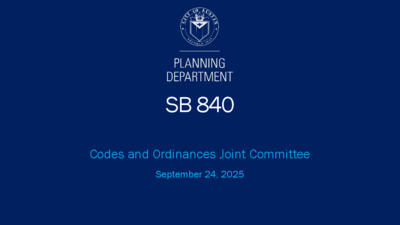Item 2 SB 840 Impacts Presentation — original pdf
Backup

SB 840 Codes and Ordinances Joint Committee September 24, 2025 Agenda SB 840 Overview Impacts of SB 840 Next Steps SB 840 Overview SB 840 Summary Allows by-right mixed-use or multifamily in all zoning districts that allow non-residential uses (excluding zones with heavy industrial). Sets minimum standards for height, density, and maximum setbacks for multifamily and mixed-use developments in commercial zones. Exempts residential conversions of existing commercial or office buildings from impact fees and other city requirements. Effective Date: September 1, 2025. SB 840 Applicability: Residential By Right Allows residential by-right on any property where mixed-use, office, commercial, retail, or warehouse uses are currently allowed in the zoning district. Does not apply to: – Zones that allow a heavy industrial use – Properties within 1,000 ft. of a heavy industrial use or development site or within 3,000 ft. of an airport or military base – An area designated by a city as “a clear zone or accident potential zone” SB 840 Applicability: Residential By Right (cont.) Residential is allowed by right in the following zoning districts in Austin: – All office base zones: – Neighborhood Office (NO), Limited Office (LO), General Office (GO) – All commercial base zones: – Community Recreation (CR), Neighborhood Commercial (LR), Community Commercial (GR), Lake Commercial (L), Central Business District (CBD), Downtown Mixed-Use (DMU), Warehouse/Limited Office (W/LO), Commercial Services (CS), Commercial Highway (CH) – Special purpose base zones: – Agriculture (AG), Planned Unit Development (PUDs)* – Industrial base zones: – Research & Development (R&D)* – Regulating plans: – Lamar/Justin, Plaza Saltillo, MLK, East Riverside Corridor, North Burnet/Gateway Regulating Plans *Applicable to properties with PUD and R&D zoning that allow commercial uses & prohibit heavy industrial uses SB 840 Applicability: New Minimum Entitlements Bill sets new minimum entitlements for “mixed-use residential” and “multifamily residential” development, for sites where SB 840 applies. – Mixed-Use Residential = any site in which the residential uses are at least 65% of the development’s total square footage. – Multifamily Residential = any site for 3 or more dwelling units within one or more buildings. New Minimum Entitlements Under SB 840 Density: – Cities must allow the greater of 36 units per acre or the highest residential density currently allowed in the city. This is 54 units per acre in Austin. – Cannot restrict floor-area-ratio (FAR) Height: – Cities must allow the greater of 45 feet or the height that currently applies to a non-residential use on the same site. Setbacks: – Cities must allow the lesser of 25 feet or the setback that currently applies to a non-residential use on the same site. Impacts of SB 840 General Impacts to Density Bonus Programs Density bonuses that do not allow additional height, such as VMU, are likely no longer viable. Density bonuses that allow additional height, such as DB90, DBETOD, ERC, TOD, and NBG, may be less attractive than what’s available by right for developments, post-SB 840 – Viability likely varies by location or other factors, such as higher construction cost per sq. ft. for podium construction. Affordability Unlocked projects may have to compete with market- rate developers on more properties, potentially leading to higher land costs for subsidized affordable housing developments. SB 840 Impacts for Tiered Citywide DBs / DBETOD Council initiated changes on June 5 to create new tiered density bonus programs and revise the existing VMU and DB90. Goals from the resolution included direction to: – Look at additional types of community benefits – Analyze requirement for partial or full replacement of existing affordable units Staff will analyze the new development reality post-SB 840 to understand whether bonus programs could “pencil” with the same, fewer, or more benefits than are required today. Downtown Density Bonus (DDB) Produces highest density/heights and the most affordable housing fees-in-lieu in the City. CBD and DMU zoning today: – CBD zoning has no height limit but has FAR limit of 8:1. – DMU zoning has height limit of 120’ and FAR limit of 5:1. DDB allows for developments to go above their base entitlements. – In general, DDB can increase CBD and DMU sites: – Up to 25:1 FAR – Up to unlimited height Downtown Density Bonus (DDB) SB 840 Impacts on DDB: – Removes FAR limits for developments with residential – Allows CBD sites unlimited height (lack of max. height in CBD) & unlimited FAR – Allows DMU zoning to develop to 120’ tall with unlimited FAR – Greatly reduces the incentive for parcels zoned CBD to participate in DDB – Loss of affordable housing fees-in-lieu and “Great Streets” participation Potential Regulatory Revisions to Consider: – Add height limit to CBD consistent with 8:1 FAR Additional Impacts of SB 840 Impacts on legacy commercial districts and regulation of active uses Airport Overlay impacts FLUMs and Neighborhood Plan Amendments Waterfront Overlay For updates, an information sheet, and information on potential amendments, visit SpeakUpAustin.org/LDCUpdates Next Steps Next Steps for Density Bonus Programs Update Land Development Code to establish a Central Business District base height & update Downtown Density Bonus to incorporate CBD height limit Develop staff proposals for new citywide tiered density bonus system that accounts for SB 840 impacts Evaluate other types of incentives for affordable housing, beyond density bonus programs Identify additional changes and amend Land Development Code as needed Thank You